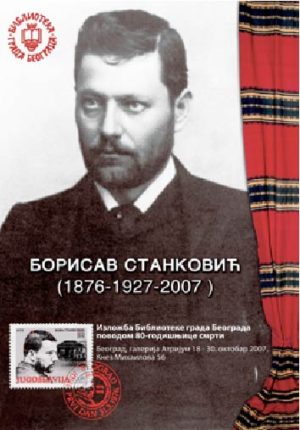
Borisav Stanković: 2007
Exhibition design:
Snežana Rajković
The exhibition was organized in 2007, on the occasion of the 80th anniversary of the writer's death


Snežana Rajković
The exhibition was organized in 2007, on the occasion of the 80th anniversary of the writer's death
The documentary exhibition about the great Serbian novelist, storyteller and playwright Borisav Stanković, is based mostly on the research of materials in Vranje, where the beginnings of the writer’s life and work are recorded. The life of that almost oriental town and its inhabitants were a constant inspiration for Borisav Stanković’s literary work. The introductory posters present the writer’s birthplace, first photographs, poetry manuscripts and school certificates. Further education, creativity and maturity are connected to life in Belgrade. Documentation from that period, primarily related to movement in the service, can be found in the archives of Serbia, Serbia and Montenegro (today the Archives of Yugoslavia) and the SASA Archives, which is precisely stated in the exhibition catalogue.
Several posters present manuscripts, books and photographs of the most important collections of short stories, including part of the manuscripts of the novel “Nečista krv” and the play “Koštana“, richly illustrated with photographs and play posters, which are kept in the Museum of Theatrical Arts of Serbia.
Borisav Stanković’s cooperation with “Beogradskim opštinskim novinama” during the Great War is presented on two posters. Life in occupied Belgrade remained as a testimony in incomplete diary entries (“Pod okupacijom”).
The exhibition was hosted in Vranje as part of the manifestation “Bora’s Week” in 2008.
It should be mentioned that the material about the life of Borisav Stanković is quite scarce, at least as far as photographs are concerned. The reason is that the writer’s house in Dorćol burned down during the bombing of Belgrade and, with it, numerous documents about the writer and his activities.
“I came to realism spontaneously, without thinking about it. At that time, I did not know what naturalism or idealism was. I am a person who is not interested in theories or intellectual constructions. Intelligence does not create works of art; it can understand or polish what the senses make…
My way of working is very simple. I carry a scene in my head until the end and only then put it on paper… Of course, corrections are imposed later on. But this also happens: I have one scene, almost finished. I start to write it, and unexpectedly under that scene, another solution appears, another grouping, another image, which had never presented itself to me in spirit until that moment. That new solution is so strong that I follow it without thinking. Only if, after a few days, I manage to reduce the written scene to the imagined one. Sometimes it turns out that the unexpected solution is better than the one imagined, and then I leave it, but…
No, I don’t like to work. And it is difficult; it’s like when a man starts digging…
My conception of art is also simple: art, if it does not trigger some noble feelings in you, is not art. Second, it should make you love your neighbour.
If a man cannot always give something better and stronger than he gave before, it is best not to give anything at all.”
(From an interview with Branimir Ćosić)
The exhibition can be viewed here.
The catalogue can be viewed here.
